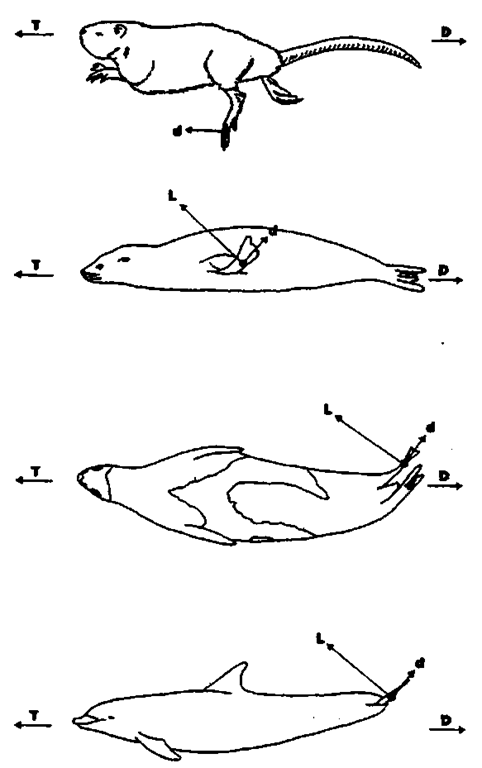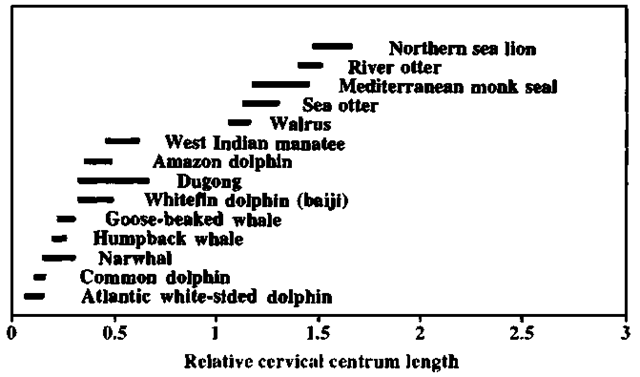Convergent evolution is the independent development of the same characters or group of characters in species whose common ancestor does not possess them. The resulting similarity in appearance is termed a homoplasy. Convergent evolution is typically associated with adaptation to similar environments. Because the constraints of the aquatic environment are extreme, they provide very powerful selection pressures on animals, such as mammals, that secondarily enter the water from terrestrial environments. Often these animals have independently evolved similar functional solutions in response to the same selective pressures and therefore show convergence in anatomy and/or behavior. Seacows, desmostylians, whales, pinnipeds, hippopotamuses, and otters almost certainly represent separate invasions of aquatic environments by mammals. Some authors believe that pinnipeds, which include sea lions, seals, and walruses, represent not a single but as many as three different invasions of the water.
In contrast to the air, water is very dense, has a high thermal conductance and capacity, and has a very low oxygen concentration. Even marginal marine species must evolve new modes of aquatic locomotion; most exploit aquatic plants or animals as food. Animals that spend most or all of their lives in water often have layers of blubber to conserve heat, higher than average rates of basal metabolism, and a wide range of physiological adaptations that ensure high levels of oxygen uptake, storage, and transport. Because chemicals, light, and sound travel differently in water than in air, chemosensation. vision, and audition are usually modified to allow efficient defense, orientation, and communication.
Ample evidence exists that the highly restrictive marine environment has repeatedly selected for similar characters that enhance life in the water across a wide range of mammalian taxa. Nevertheless, anatomical and/or functional similarity need not imply convergence if the taxa involved are in fact more closely related to each other than they are to another terrestrial lineage. In such a case, the similarities of the two groups could be ascribed to common inheritance. This point, made by Wyss (1989), was used to argue for a single, monophyletic origin of all pinnipeds. To the extent that similar anatomical and physiological traits for dealing with life in the water occur in mammals with different terrestrial ancestors, they are the homoplastic results of convergent evolution. This article presents examples of convergence among marine mammals in locomotor pattern and body shape, sense organ choice and design, and circulatory physiology.
I. Convergence in Locomotor Pattern and Body Shape
All marine mammals had terrestrial ancestors with paraxial appendicular locomotion, and it is probable that transitional, semiaquatic taxa employed limb-based, paddling locomotor patterns to at least some extent. Fish (1996; Fig. 1) contrasted such drag-based propulsion with the lift-based propulsion of fully aquatic mammals. Lift-based propulsion may employ fore-limbs, hindlimbs, or a caudal fin as the lift-generating organ. Despite different swimming proficiencies and speeds, sirenians and cetaceans provide a striking example of the convergent evolution of dorsoventrally oscillating, lift-generating caudal flukes. The swimming style of the (reptilian) Jurassic ichthyosaurs was at least superficially convergent on the same pattern, although oscillation of the caudal fin was lateral instead of vertical.
Many marine mammals, especially those specialized for speed, have smooth, fusiform bodies that enhance movement through the dense aquatic medium. A smooth body reduces viscous drag produced by friction between water and the animal’s body, whereas a streamlined, teardrop shape reduces surface area and inertial drag from the pressure differences caused by movement through the water. In test objects, minimum drag is achieved when body length is approximately four to five times body width, and many fast swimmers have evolved these approximate proportions convergently. When the functional constraints of feeding allow it, hydrodynamic shape is often further enhanced by reduction of neck length. The degree of aquatic specialization of both living and fossil mammals can be estimated by measuring the relative length of cervical vertebrae (Fig. 2). Other common convergent changes in body form include the loss of external ear pinnae and the enclosure of external genitalia in body pouches to reduce drag.
Figure 1 Propulsive modes in marine mammals, from Fish (1996). From top, paddling (drag-based) in the muskrat (Ondatra zibethicus), pectoral oscillation (lift-based) in the California sea lion (Zalophus californianus), pelvic oscillation (lift-based) in the harp seal (Pagophilus groenlandicus), and caudal oscillation (lift-based) in the common bottlenose dolphin (Tur-siops truncatus). Drag (d) and lift (L) generated by the propulsive organ contribute to total thrust force (T) and drag force (D).
II. Convergence in Choice and Design of Sense Organs
Transition from land to water is typically accompanied by the modification of the sense organs for efficient use in the new environment. In very broad terms, sight plays a relatively smaller role, and hearing a larger role, in the lives of marine mammals than in those of terrestrial mammals. Nevertheless, most marine mammals see very well, especially in clear water and at short distances. Light is absorbed by water and scattered by suspended material. As a result, vision is restricted at distance, at depth, and in turbid nearshore environments. At least one species of river dolphin (Platanista gangetica) is nearly blind. Modification of the terrestrial eye for sight in lighted aquatic environments requires compensation for the lack of corneal refraction. In subaerial eyes, the cornea is a fixed refractor that depends on the different refractive indices of air and corneal tissue to bend light toward the retina. The near identity of the corneal refractive index with that of water makes it virtually useless in aquatic mammals.
Sound travels several times faster in water than in air, making hearing an optimal sense for aquatic communication and navigation. Long wavelength sound that bends around obstacles is used for long-distance communication in both whales and pinnipeds. The “songs” generated by giant mysticetes may travel hundreds or even thousands of kilometers. Navigation via short wavelength sound is highly developed in odontocete cetaceans. Although short wavelength clicks or chirps are produced by many sea lions, seals, and walruses (Odobenus ros-niarus) and by the Caribbean manatee (Trichechus manatus) (Norris, 1969), their function in either communication or navigation has not been reliably documented.
Figure 2 Convergent reduction of centrum length relative to centrum height of cervical vertebrae in marine mammals (top to bottom: Eumetopias jubatus, Lutrasp., Monachus monachus, Enhydra lutris, Odobenus rosmarus, Trichechus manatus, Inia geoffrensis, Dugong dugon, Lipotes vexillifer, Ziphius cavi-rostris, Megaptera novaeangliae, Delphinus sp., Lageno-rhynchus acutus). A short relative length enhances hydrodynamic shape and ease of movement through the water.
Adaptation of the terrestrial ear for aquatic hearing presents several significant challenges. These include the increased pressure at depth on the ear drum or tympanum, the impedance mismatch produced by the entry of sound through the air-based middle ear. and the ease with which sound from the environment enters the inner ear directly through the body. Reduction in the size of the tympanum and increases in both the density and the size of the ear ossicles have occurred conver-gently in whales and pinnipeds. In some cases, sound reaching the middle ear is supplemented or supplanted by sound traveling via the jaw. Both whales and pinnipeds have also responded to the disruption of directional information caused by the transmission of sound via many osseous routes by isolating and insulating the inner ear from the rest of the skull. In whales, this insulation involves not only soft tissue separation, but also the very dense tympanic bone.
III. Convergence in Circulatory Physiology
All marine mammals retain lungs as their dominant organs of gas exchange and are dependent on the air at the water’s surface for their oxygen supplies. Despite this restriction, many are capable of dives that persist long after oxygen in the lungs is depleted. They may tolerate such dives by decreasing the heart rate (bradycardia), by utilizing oxvgen stored in muscle or blood that has unusually high levels of myoglobin or hemoglobin, and by switching from aerobic to anaerobic metabolism. Additionally, blood may be directed away from the muscles, kidneys, and digestive tract, but its supply maintained or diverted to vital organs that constantly require oxygen, such as the brain and the heart. Hedrick and Duffield (1991) documented unusually high concentrations of red blood cells in serum (hematocrits) in those whales (belugas, Delphinapterus leucas) and seals (northern elephant seals, Mirounga angu-stirostris) that employ deep, long-duration dives. Interestingly, high hematocrits are also associated with increased blood viscosity and a reduced oxygen transport capacity, which may preclude fast sustainable swimming in these species. The extensive phylogenetic distance between whales and seals dictates that these similarities must have evolved separately in each group, making them a convincing example of convergent evolution.
Convergent evolution of animals whose aquatic habits demand long periods without breathing extends to the molecular level as well. Joysey (1988) studied the sequence of amino acids in the myoglobin molecule as a means of determining phylogenetic relationships. He found that his phylogenetic reconstructions were in some cases complicated by the occurrence of amino acids that could be associated with similar physiological requirements. When compared with those of terrestrial mammals, the myoglobins of phocids, otariids, penguins, and cetaceans all include additional arginines on surfieial sites. Their presence changes the electrical charge of the protein, allowing high-density concentration of myoglobin in the cell.


